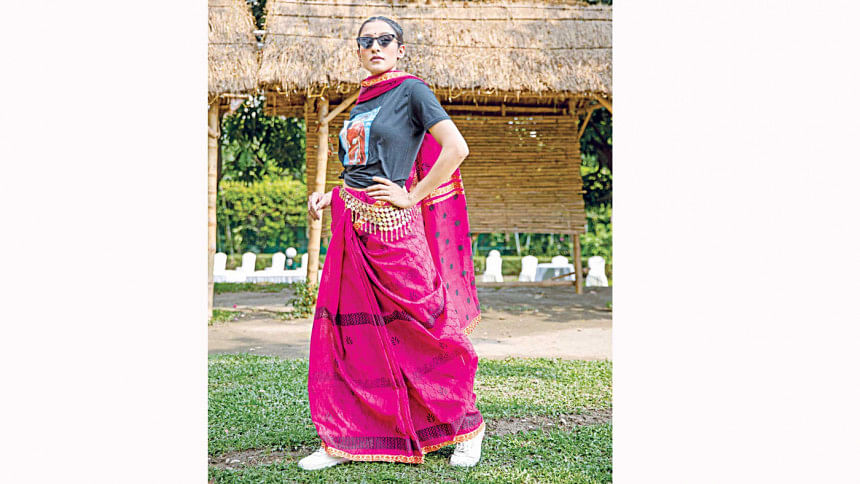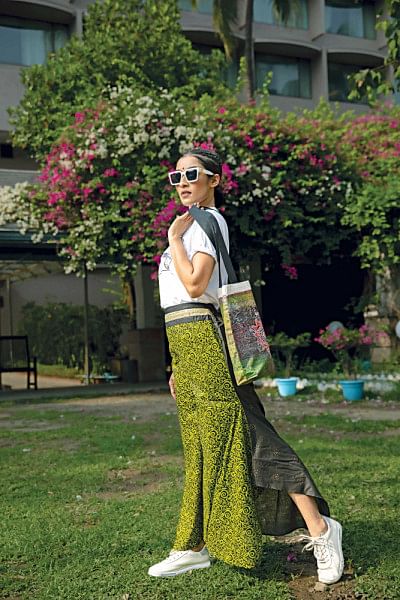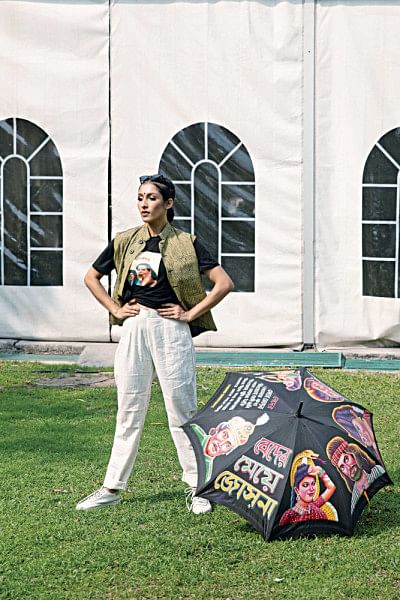The saga of Rickshaw Art and its entry into fashion

'Bhepu, Thamun, Bajan' a common catch-phrase in pedicabs or rickshaws of the eighties, is now doing its fashion rounds on tee shirts.
The magic of this avant-garde people's art or commonly called 'rickshaw art' has seeped into the folds of an increasingly cosmopolitan Dhaka. Fashion accessories, clothing, household additions, just name it, and the bright neon colours of rickshaw art are flashing glory in all forms.
Rickshaw art covers the whole rickshaw decoration from painted backboards and side panels, appliquéd hoods, the brass vases stuffed with plastic or paper flowers, the painted rectangular metal board at the backside; the tri-cycle boasts of bright splashes of colours, allowing the artist to paint their dreams with flamboyance.
They say Dhaka is the city of magic, where streets are crammed with an unofficial number of 400,000 rickshaws; so picking from their brushes and the painting the town, as well as our lives, in neon red or pink is only a very expected outcome. There have been many serious discussions on this kitsch art form and needless to say these paintings of movie stars in garish pink, electric blues and neon greens have also piqued our brains and art senses.
The artist has used his wildest imagination and multiplied them into larger than life vision; a movie star of his dreams, he drew with all his love and used the colours of his imagination to amplify her on his canvas; a serene village scene, his favourite mosque, favourite movie posters all get his equal attention.
A little inspection into these primitive people carriers, with their splurge of floral decorative seat covers and ornamental plastic strings in the shapes of quirky celestial bodies appliquéd onto the hood — you will get to see a world of baroque and extravagant designs. But when put together it gives out a bird's eye view into Bangladesh's pop culture and most importantly depicts the artist's own beliefs, expressions and aesthetics.

"It is a very expressive medium of art, where the expressions of the masses can be experienced," said Kuhu Plamondon, a reputed Bangladeshi fashion designer, who plans on reviving the once almost-vanishing art form into her medium of fashion.
Rickshaws first came to Bangladesh in the 1940s, which were then primarily undecorated functional vehicles. After the Liberation War, it became the norm to have pictures of war and freedom, portrayed on the shields at the back of the rickshaws. Then fast forward to the 80s and 90s, the illustrations involved more showbiz viewpoints like the portraits of movies stars, illustrations of landscapes, and even social messages that were both meaningful and eye-catching at the same time. Today, the art form has a more religious aesthetic, but more importantly is getting subdued by the emergence of digital prints, a cheaper alternative to the original hand-painted versions.

"I still remember my Art College days,' post-independence, these rickshaws brought colour to the otherwise mundane streets of Dhaka. The more attractive a rickshaw was, greater its chance of being hired. Rickshaw art is an inherent part of our culture, I personally consider it as "people's art," serving as a medium of expression to the artists' feelings towards humanity, entertainment, and even devotion, we simply cannot lose it or remove it from mainstream pop culture," says Plamondon.
And as an experimental attempt to stop the popular art from fading, Kuhu Plamondon has collaborated with famed designer Chandana Dewan to revive the sensibility of the art on a different canvas. Everyday comfortable wear like tee-shirts, jeans, bags and umbrellas are being bedecked with the slogans and catch phrases or even faces of movie stars of rickshaw art. With this, they hope to encourage the current generation towards appreciating the art form and the efforts of the original craftsmen, the rickshaw artists.
Md Dewan Miah, a rickshaw artist of the capital, was quite sceptical about the future of the business. According to the astute painter, fleets of rickshaws were now bought by businessmen instead of the rickshaw pullers, and hence the former contacted the artists directly for any painting order. According to Dewan, these men opted for a more economical version. "They want digital prints because it is easier to print, takes much less time to apply and is more cost effective," reflected the artist.

And hence we understand that the days of these old-fashioned art may be numbered, and their ingenious artists may disappear with time. Today, the art form and the artists are both suffering through a struggle for survival, and maybe sometime in the future we will no longer be swept up by a swirl of garish colours and loud stories of expressions, which have for so long kept our streets bustling and alive.
The admission of rickshaw art into fashion is a commendable way to keep alive this unique genre of art. Wear these tees and flaunt your colours.
Photo: Sazzad Ibne Sayed
Model: Tarin
Styling: Sonia Yeasmin Isha
Makeup: Sumon Rahat
Wardrobe: Kuhu Plamondon & Chandana Dewan
Essentials: The Rickshaw art collection by Kuhu Plamondon and Chandana Dewan are available at Chondon's

 For all latest news, follow The Daily Star's Google News channel.
For all latest news, follow The Daily Star's Google News channel. 



Comments